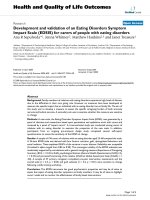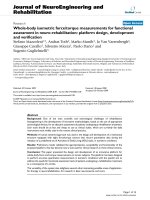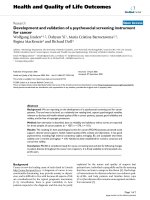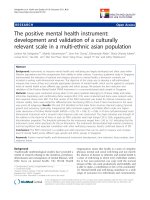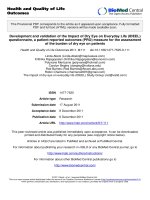Muffler design, development and validation for pdf
Bạn đang xem bản rút gọn của tài liệu. Xem và tải ngay bản đầy đủ của tài liệu tại đây (5.26 MB, 11 trang )
Downloaded from SAE International by Univ of California Berkeley, Tuesday, July 26, 2016
Muffler Design, Development and Validation for
Acoustic Advantages on Automotive Vehicles
2011-01-2215
Published
09/13/2011
Shitalkumar Ramesh Shah and Gangadhar GS
Volvo India Pvt Ltd
Copyright © 2011 SAE International
doi:10.4271/2011-01-2215
ABSTRACT
Noise pollution has become one of the major environmental
concerns in present era. With the ever tightening laws and
increasingly straight regulations for controlling noise
pollution of automotive vehicles, mufflers are important part
of engine system and commonly used in exhaust system to
minimize noise caused by exhaust gases. Design of mufflers
is a complex function that affects the noise characteristics and
fuel efficiency of the vehicle. Traditionally, muffler design
has been an iterative process by trial and error method.
However theories and science that has undergone
development in recent years has given a way for an engineer
to cut short number of iterations. In today's competitive world
market, it is important for a company to shorten product
development cycle time and thereby cost.
The objective of this paper is to propose a practical approach
to design, develop and validate muffler practically which will
give advantage over conventional method. This paper also
emphasis on how modern CAE tools could be leveraged for
optimizing overall system design balancing conflicts like
noise and back pressure. The project is considered for
validation plan on real time vehicle application to realize
objective of design as future scope of work.
INTRODUCTION
Since invention of internal combustion engine in latter part of
nineteenth century, noise created by it has been a constant
source of trouble to environment. Significantly, exhaust noise
in terms of pressure is about 10 times more than all other
noises (structural noise) combined. So problems of reducing
engine noise consistently, mainly in attenuating exhaust noise
are a challenge.
The design of mufflers has been a topic of great interest for
many years and hence a great deal of understanding has been
gained. Most of the advances in theory of acoustic filters and
exhaust mufflers have come about in last four decades. Hence
good design of muffler should give best noise reduction and
offer optimum backpressure for engine. Moreover, for a
given internal configuration mufflers have to work for a
broad range of engine speed.
Usually when mufflers are designed by well established
numerical techniques like boundary element method or finite
element method, numerical model generation is time
consuming often limiting user to try various other possible
design alternates. The process might be lengthy and laborious
as it involves more iteration with different prototypes. The
process discussed in this paper will help in overcoming above
mentioned drawbacks.
BRIEF OVERVIEW OF EARLIER
WORK
Mufflers have been developed over last ninety years based on
electro- acoustic analogies and experimental trial and error.
Many years ago Stewart used electro - acoustic analogies in
deriving basic theory and design of acoustic filters [1]. Later
Davis et al. published results of a systematic study on
mufflers [2]. They used travelling wave solutions of onedimensional wave equation and assumption that acoustic
pressure ρ and acoustic volume velocity υ are continuous at
changes in cross sectional area. An important step forward in
analysis of acoustical performance of mufflers is application
of two- port network theory with use of four -pole
parameters. Igarashi and his colleagues calculated
transmission characteristics of mufflers using equivalent
electrical circuits [3-4]. Sreenath and Munjal gave expression
for attenuation of mufflers using the transfer matrix approach
Downloaded from SAE International by Univ of California Berkeley, Tuesday, July 26, 2016
[5]. The expression they developed was based on velocity
ration concept. Later, Munjal modified this approach to
include the convective effects due to flow [6]. Young and
Crocker used the finite element method to predict four-pole
parameters and then transmission loss of complex shaped
mufflers for case of no flow [7].
Ying-chang, Long-Jyi used optimized approach of maximal
STL and muffler dimension under space constraints
throughout the graphic analysis as well as computer aided
numerical assessment [8]. Middlberg,J.M. and Barber T.J.
present different configurations of simple expansion chamber
mufflers, including extended inlet or outlet pipes and baffles
have been modeled numerically using CFD (Fluent −12) in
order to determine their acoustic response [9]. However, most
of the research studies based on formulation of mathematical
equation and trial and error method. T. Rose and Jebasinski J.
describes the application of a “Design of Experiment”Method (Taguchi-Method) to reduce the tail-pipe noise of an
exhaust system, the Taguchi-Method was applied to three
different exhaust systems[10]. Several geometric parameters,
such as pipe diameter and length or muffler volume, have
been changed at each exhaust system.
For the prediction of TL acoustic chambers in mufflers, an
approach that has had wide acceptance is based on acoustic
filter theory. However, acoustic filter theory does not provide
a complete theoretical explanation of the action of acoustic
chambers, since when an acoustic filter passes a certain upper
frequency limit; it ceases to behave in the way predicted by
the simple plane-wave theory. Moreover, in many cases when
the chamber configuration is complicated, the simple onedimensional theories cannot give a complete explanation of
the chamber behavior because of the complex wave
phenomena which exist. However, most of the research
studies based on formulation of mathematical equation and
trial and error method.
SCOPE OF THE WORK
We must understand that complexity of muffler design is in
incorporating noise reduction on meeting the required
(legislative) targets, without affecting engine performance,
package protected to the available space and ultimately
maintaining reasonable cost targets and production time. This
defines scope of our work and intent is to develop a practical
approach to design muffler device which will have following
advantages:
i. A brief background on evaluation of muffler concept
design for proto type and validation with new approach.
ii. A methodology has been developed for optimum design
stages and less cost for muffler design by balancing various
parameters.
iii. A practical tool to estimate quality of muffler design,
which is used for concept selection and filter out best concept
proposal at initial phase of design.
iv. A practical approach for muffler design to optimize
product development time and cost by balancing conflicting
requirements like noise and back pressure.
Design approach by modern CAE tools is used for optimizing
overall system design to choose the best concept. CFD
analysis of muffler included in scope is to verify flow
restrictions (engine-back pressure) and TL characteristics is
computed by acoustic analysis using 3D analysis LMS virtual
lab for noise prediction. To establish a design methodology to
make design process simpler and less time consuming by
making use of acoustic theories [11, 12] and experience in
short practical approach to get better design.
A PRACTICAL APPROACH -DESIGN
METHODOLOGY
The properly designed muffler for any particular application
should satisfy often - conflicting demands of at least five
criteria simultaneously
Muffler design methodology for a given vehicle involves 7
steps. Following are broad steps followed to arrive at a good
design of muffler making use of practical experimental data.
STEP 1: TARGET SETTING AND
BENCHMARKING
The first step is to measure the unmuffled noise spectrum of
engine for vehicle under consideration. This spectrum is
recorded at 1m or 0.5 m and 45degree from exhaust outlet by
replacing muffler with normal exhaust pipe. The major
frequencies are noted down and these become input to design.
The peaks in the unmuffled spectrum are major contributors
to vehicle exhaust noise and these are needs to attenuate to
achieve required noise level. Target values are set based on
benchmarking (pass-by results) and vehicle class
requirements. Back pressure values are defined based on
engine requirements.
STEP 2: TARGET FREQUENCIES
After recording unmuffled noise spectrum, one needs to
calculate target frequencies to give more concentration for
higher TL. Target frequencies are calculated by using engine
data as follows,
Theoretical computation
The exhaust tones are calculated using following formulae:
[13] (1)
(2)
Downloaded from SAE International by Univ of California Berkeley, Tuesday, July 26, 2016
Figure 1. Properly designed muffler -five criteria.
(3)
The exhaust spectrum is measured with suitable
instrumentation for identification of these CFR and EFR. An
order tracking analysis can be done to identify order of noise
data.
By comparing theoretical target frequencies and frequencies
found out from analysis study, dominant frequencies are
identified.
Best possible configuration among the concepts as designed
above is selected based on the best acoustic performance
(maximum TL) and backpressure (least).
Perforations: Perforated pipe forms an important acoustic
element of muffler, which is tuned in line with the
problematic frequencies identified in step 2. The diameter of
hole to be drilled or punched on pipe is calculated by a
equation as given below:
(5)
STEP 3: MUFFLER VOLUME
CALCULATION
Porosity: Porosity, σ is given by
Based on experience and theory of acoustics for muffler
design for various engines, the following equation is used.
Volume of muffler (Vm):
[13] (6)
[13] (4)
Now design has to be verified for packaging space that can be
made available for the muffler.
STEP 4: INTERNAL CONFIGURATION
AND CONCEPT DESIGN
Based on benchmarking TL and target frequencies, few
concepts of internal configurations for muffler that meets
packaging dimension within volume mentioned above has to
be portrayed.
It is important to note that lesser the porosity is more
restriction and hence more will be backpressure.
The open area ratio Aop is given by,
(7)
At this stage, diameter of hole to be drilled, pitch, number of
holes per row and number of rows for each pattern of holes is
decided. The distance at which perforation starts and at which
the perforation ends is also decided. Thus, the design of the
perforated tube for individual hole patterns is finalized.
Downloaded from SAE International by Univ of California Berkeley, Tuesday, July 26, 2016
Design based on the above criterion is carried forward for
virtual simulations.
STEP 5: VIRTUAL SIMULATION
Based on above mentioned approach, different concepts will
be arrived with optimum combinations of different elements
inside volume of silencer. Finalized concepts will be verified
virtually using CAE simulation software's towards
achievement of TL and back pressure.
CFD ANALYSIS
When steady air flow passes through mufflers, steady
pressure drop is developed which is related to flow and
geometry of air passages. Pressure drop in an exhaust muffler
plays an important role for the design and development of
mufflers.
Prediction of pressure drop will be very useful for design and
development of muffler. To predict pressure drop associated
with the steady flow through muffler, CFD has been
developed over last two decades. So the flow prediction can
be made reliable.
TRANSMISSION LOSS ANALYSIS
Prediction of transmission loss virtually is an important
analysis required for development of muffler at an initial
design stage. There are different software packages available
in market for predicting TL. We have used LMS virtual lab
for TL predictions.
Limitations of the CAE tools also has to be taken care, as the
co-relation at higher frequencies is difficult since the plane
wave theory holds good only up to 3000 Hz beyond which
wave is no more 2 dimensional but 3 dimensional for which
computations are far complex to match practical results.
Hence need of research to blend both strengths of CAE and a
practical result obtained by a practical approach or
methodology is required. After completion of simulation best
three concepts will (with less back pressure and higher TL)
be taken forward for prototype manufacturing to check for
TL and back pressure physically.
STEP 6: PROTOTYPE
MANUFACTURING
All above stages combined with packaging of engine evolve
design of prototype muffler and can be taken up for
manufacturing.
Following are some of important manufacturing
considerations summarized based on experience:
1. There should not be any leakage of gas from one chamber
to another.
2. Full welding is better than stitch welding.
3. Acoustic performance of extruded tubes with perforations
is better than the tubes that are made out of perforated and
welded sheets.
4. CEW or ERW tubes are the common materials used.
5. Either of Crimping or full welding of jacket can be used.
6. Either of flanged or flared tubes can be used as end
connections of the muffler.
However, with leakage point of view, flanged connections are
better. But at the same time, this adds to weight and cost of
the exhaust system. Bearing all above in mind, a physical
prototype is made in such a way that there will not be any
tooling investment for prototype.
STEP 7: EXPERIMENTAL TESTING
AND DESIGN FINALIZATION
The experimental determination of backpressure on engine
and TL using two source method for different concepts are
verified. The prototypes of all concepts that are made at
above step are tested for TL to verify target value.
TL is difference in sound pressure level between incident
wave entering and transmitted wave exciting muffler when
muffler termination is anechoic, TL is a property of muffler
only. In this work an attempt has been made to
experimentally measure TL by actually using the
experimental set-up. Two source techniques gives good
results for measurement of TL at the different sound
frequencies. Also absence of anechoic termination, the
decomposition method is found to be ineffective. Therefore
we will be using two source methods in calculating TL.
TL values obtained from simulations are compared with
experiments. At the same time if performance of muffler is
found to be satisfactory as per engine noise requirement, then
the above captured data becomes the input for further
backpressure reduction. The iteration is continued usually 2
to 3 times to achieve an optimum balance between noise
requirement and target of least backpressure and best fuel
efficiency.
CASE STUDY
DEFINING THE CASE
We have attempted application of these design methodology
on LC diesel engine vehicle. Initial we got only basic engine
details and uncut layout of vehicle for designing exhaust
system.
Downloaded from SAE International by Univ of California Berkeley, Tuesday, July 26, 2016
Figure 2. Muffler design methodology - schematic representation.
STEP 1: BENCHMARKING
STEP 2: TARGET FREQUENCIES
As per design methodology we benchmarked same kind of
engine models to set the target of TL of muffler.
To find fundamental frequency
Cylinder firing rate: CFR to be calculated as per equation (2),
Bore diameter (D) = 80 mm, Stroke length (L) = 98 mm,
Number of cylinders (n) = 4, Engine power (P) = 65 hp, Max.
RPM (N) = 3500 rpm, Allowable back pressure = 12″ of
H2O, TL noise target (muffler) = 20 dBA
Engine firing rate: EFR to be calculated as per equation (3),
The first 4 harmonics are to be suppressed as higher order has
very little effect on noise. The diameter of the holes drilled
should suppress these frequencies.
Downloaded from SAE International by Univ of California Berkeley, Tuesday, July 26, 2016
STEP 3: MUFFLER VOLUME
CALCULATION
Volume swept of each cylinder calculated as per equation (4)
STEP 5: VIRTUAL SIMULATION
All three concept of muffler designed as per above steps are
tested for flow analysis using CFD simulation tool.
STEP 4: INTERNAL CONFIGURATION
OF MUFFLER AND CONCEPT DESIGN
Diameter of muffler calculated as per equation (5), (6)
Open area and porosity for each muffler concept calculated
by using equation (6) and (7)
Design outputs
Table 1. Design table (output results).
Figure 3. CFD concept 0A.
Below mentioned are few important design guidelines
captured from theory of acoustics and experience while
designing the muffler
a. Extended inlet and outlet diameter will be minimum 60 to
70 mm for better attenuation results
b. Inlet and outlet are introduced 180 degree reversal to
increase the acoustic performance
c. From benchmark and theory, 3 expansions chambers are
suggested for noise attenuation (two baffles play a major role
in back pressure and acoustic advantages).
Figure 4. CFD concept 0B.
d. Hole perforations choose to match frequency that needs to
be suppressed based on CFR and EFR calculations
e. la and lb is 15 to 20 mm as per theory of acoustic for good
acoustic performance
f. Primary criterion for choosing diameter of the hole is
based on the first four CFR and EFR harmonics
We have made design of concept 01, 02, and 03 with double
expansion chamber. Expansion chambers are made of
unequal length in two parts. Elliptical chamber is used as we
have advantage of space and better attenuation. To get more
attenuation effect inlet and outlet tubes are extended in the
chamber [10, 11].
Figure 5. CFD concept 0C.
Downloaded from SAE International by Univ of California Berkeley, Tuesday, July 26, 2016
Figure 6. Comparison virtual acoustic results.
Assumption and boundary conditions
• Flow is considered to be steady
• Air is considered as medium for computations
• Turbulent flow is considered (K-ε Model)
• Inlet is considered as mass flow boundary condition with
320 kg/hr flow rate
• Inlet temperature of fluid is 520 degree C
• Outlet considered as pressure outlet opened to atmosphere
Figure 2, 3 and 4 shows flow through concept 0A, 0B and 0C
mufflers. CFD results shows that concept 0A is good for back
pressure as it provides less back pressure compared to
concept 0B and concept 0C.
VIRTUAL ANALYSIS
The mean flow performance of three mufflers considered in
acoustic analysis has been assessed. Assumption and
boundary conditions
• Sound termination is anechoic
• Perforated tubes are simulated using Sullivan-Crocker and
Mechel's relation
• Linear steps for analysis is 10 Hz in the frequency range of
10 - 2000 Hz
• Holes on tubes with zigzag pattern are modeled as parallel
pattern
• Embossing on inlet and outlet end cover of muffler is
neglected
As per virtual analysis TL results concept 0A is having better
TL compared to concept 0B and concept 0C at critical
frequencies (20 - 500 Hz or for initial four frequencies) as per
figure 06
After completion of simulation we selected best three
concepts (with minimum back pressure and higher TL) taken
forward for prototype manufacturing to experimental
validations of TL and back pressure.
STEP 6: PROTOTYPE
MANUFACTURING
Final 3 concepts were manufactured by taking care all things
from step 6 of design methodology and in such a way that
there will not be any tooling investment for prototype.
STEP 7: EXPERIMENTAL TESTING
AND FINALIZATION OF DESIGN
As explained in step 7 of design methodology we have used
two source method for TL experimental validations for proto
type manufactured mufflers. Flow diagram for the
experimental set up of TL measurement is as shown in figure
6. Also all three concepts are tested on engine experimentally
for back pressure measurement.
OBSERVATIONS
As per figure 8, TL of concept 0A is better compared to
concept 0B and 0C at critical frequencies.
Downloaded from SAE International by Univ of California Berkeley, Tuesday, July 26, 2016
Figure 7. Flow diagram for experimental set up TL measurement.
Figure 8. Comparison between experimental results.
Figure 9. Comparison analysis and experimental concept
0A.
Figure 10. Comparison analysis and experimental
concept 0B.
Downloaded from SAE International by Univ of California Berkeley, Tuesday, July 26, 2016
REFERENCES
1. Stewart, G. W. “Acoustic wave's filters,” Physics Review
20, 528-551(1922).
2. Divis, D. D. Jr., Stokes, G. M., Morse, D., and Stevens, G.
L., “Theoretical and Experimental Investigation of Muffler
with Comments on Engine- Exhaust Muffler Design,” NACA
1192 (1954).
3. Igarashi, J. and Toyama, M., Fundamental of acoustical
silencers (I), Aeronautical Research Institute, University of
Tokyo, Report no.339, 223-241 (1958).
Figure 11. Comparison analysis and experimental
concept 0C.
Comparing virtual acoustic results as per figure 6 and
experimental results as per figure 8, TL of concept 0A is
suppressing initial four critical noise frequencies. Also figure
9, 10 and 11 is comparison between analysis and
experimental results of frequency v/s Transmission loss for
muffler concept 0A, 0B and concept 0C. The dotted vertical
lines represent EFR's and plot explains that TL curve of
proposed concept suppresses critical vertical peaks.
The obtained result using experimental setup is compared
with theoretical result and virtual simulation results to find
out best concept for noise. Also for back pressure CFD
results are compared with engine back pressure results. Based
on this comparison concept 0A is selected for required back
pressure and noise (TL) as results are near provide targets.
Further to test selected muffler (0A as per case study) on
vehicle to meet pass-by-noise requirements.
CONCLUSIONS
4. Igarashi, J. and Toyama, M., Fundamental of acoustical
silencers (III), Aeronautical Research Institute, University of
Tokyo, Report no.351, 17-31 (1960).
5. Munjal, M. L., Sreenath, A. V. and Narasimhan, M. V.,
“Velocity ratio in the analysis of linear dynamical system,”
Journal of sound and Vibration 26, 173-191 (1970).
6. Munjal, M. L., “Velocity ratio cum transfer matrix method
for the evaluation of muffler with neon flow,” Journal of
sound and Vibration 39, 105-119 (1975).
7. Young, C. I. J. and Crocker, M. J., “Prediction to
transmission loss in mufflers by finite element method,”
Journal of Acoustical society of America 57, 144-148 (1975).
8. Chang, Ying-Chun, Yeh, Long-Jyi, chiu, Min-Chie,
“Computer Aided Design on Single Expansion Muffler with
Extended Tube under Space Constraints,” Journal of Science,
171-181 (2004).
9. Middelberg, J. M., Barber, T. J. and Leong, T.J.,
“Computational fluid dynamics analysis of the acoustics
performance of various simple expansion chamber mufflers,”
Acoustics, 123-127 (2004).
This paper emphasizes on importance of design methodology
- a practical approach from the concept design to proto
manufacturing
10. Rose, T. and Jebasinski, R., “Design of Experiment Application of a Statistical Evaluation Method to Optimize
the Tailpipe Noise of an Exhaust System,” SAE Technical
Paper 2003-01-1655, 2003, doi:10.4271/2003-01-1655.
and validation of exhaust muffler. This design methodology
will help designers in understanding importance of each step
of designing in detail from concept level to validation level.
This approach serves purpose of reducing number of
iterations, product development time and cost with better
design.
11. Erilksson, L. J. and Thawani, R. T., “Theory and Practice
in Exhaust System Design,” SAE Technical Paper 850989,
1985, doi:10.4271/850989.
Although practical approach has become an important tool in
making muffler design more of an art than a science, need for
design verification will always be necessary at end of each
step.
12. Munjal, M. L., “Acoustic of ducts and mufflers,” John
Weley and Sons (1987).
13. Bentley, Philip and Morrison, John C., “The Scientific
design of exhaust and intake system,” Robert Bentley, Inc.
Cambrige, Massachusetts (1971).
Downloaded from SAE International by Univ of California Berkeley, Tuesday, July 26, 2016
CONTACT INFORMATION
n
No. of cylinder
Shital Shah is currently working in the product development
division of Volvo India Pvt. Ltd. He can be contacted at
d
www.volvotrucks.com
Gangadhar GS is currently working in the product
development division of Volvo India Pvt. Ltd. He can be
contacted at
Diameter of muffler
d1
Diameter of hole
D
www.volvotrucks.com
DEFINITIONS/ABBREVIATIONS
CFD
ID of cylinder bore
L
Stroke Length
Computational Fluid Dynamics
n1
Area Ratio
N
Expansion. Ratio
ƒ
Cylinder firing rate
C
Engine firing rate
S
Open area ratio
N
transmission loss
ƒF
unit area of surface, m2
L
Volume of Muffler
m
Volume of Muffler with factor mm
Vf
AR
ER
CFR
EFR
Aop
TL
A
V
Vm
Vs
Swept volume
No of holes / row
Max RPM
frequency. Hz
Pitch between hole
cross-sectional area of duct, m
engine speed rpm
firing frequency
length of duct m
expansion ratio
Volume factor for muffler
Downloaded from SAE International by Univ of California Berkeley, Tuesday, July 26, 2016
fc
cut off frequency
P
Engine power, hp
σ
Porosity
la
Length at which perforation starts on pipe
lb
Length at which perforation ends on pipe
CEW
Cold drawn electric resistance welded
ERW
Electric resistance welded
The Engineering Meetings Board has approved this paper for publication. It has
successfully completed SAE's peer review process under the supervision of the session
organizer. This process requires a minimum of three (3) reviews by industry experts.
All rights reserved. No part of this publication may be reproduced, stored in a
retrieval system, or transmitted, in any form or by any means, electronic, mechanical,
photocopying, recording, or otherwise, without the prior written permission of SAE.
ISSN 0148-7191
Positions and opinions advanced in this paper are those of the author(s) and not
necessarily those of SAE. The author is solely responsible for the content of the paper.
SAE Customer Service:
Tel: 877-606-7323 (inside USA and Canada)
Tel: 724-776-4970 (outside USA)
Fax: 724-776-0790
Email:
SAE Web Address:
Printed in USA



